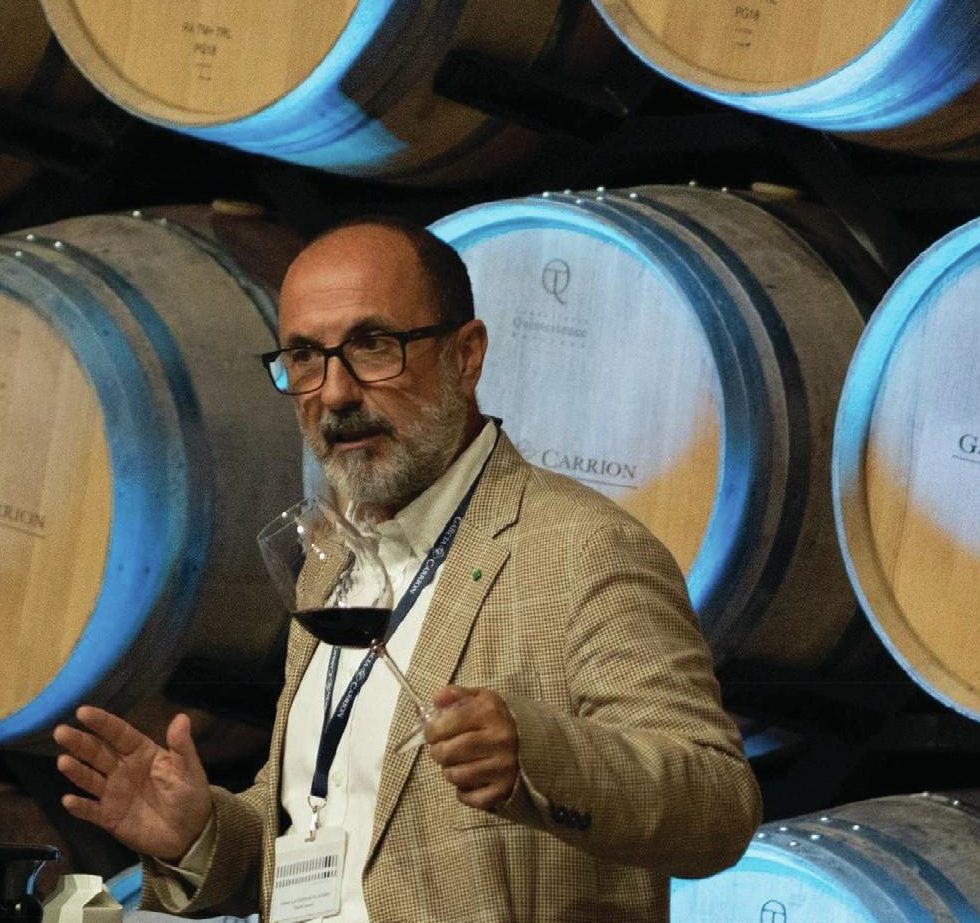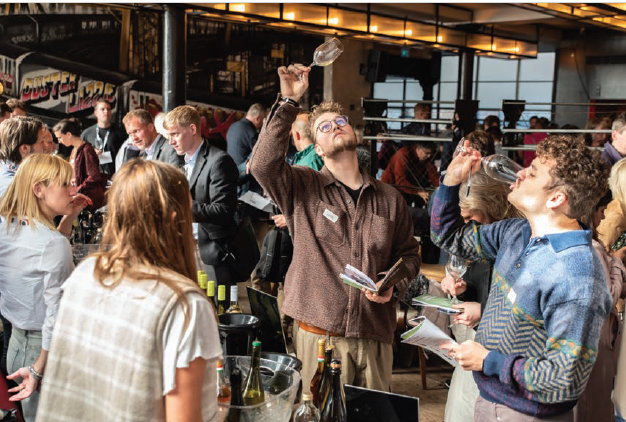Don’t look back in anger
As the end of a turbulent year approaches, takes a look at the ups and downs and the movers and shakers, as reported by the drinks business and sees that there really is a lot to celebrate about 2003 Robyn Lewis
January
2003 KICKED OFF with two pieces of news that would come to dominate the trade for much of the rest of the year. First was the news that Safeway, one of the UK’s biggest multiple retailers, was up for sale.
The ensuing saga was played out in the trade and national press amid fears of a sale to Wal-Mart or Sainsbury’s, leaving the UK supermarket sector with just three main players.
An offer from Morrisons looked like a good bet, until the £2.7 billion offer was considered far too low by Safeway shareholders and a bidding war ensued. The highs and lows of the drama were to punctuate the year.
The second piece of news that dominated was the BRL Hardy/Constellation wine merger. The rumour mill started at the beginning of the month and by the end the merger was all but a done deal.
The US giant would now be the world’s biggest wine operation, with potential sales of US$1.9bn. Big new product launches were thin on the ground, as you might expect at this time of year, but nonetheless there were a few memorable additions to the industry.
A new Argentinean brand, Lo Tengo, was released from the Berkmann Wine Cellars stable, complete with the first ever (it is claimed) lenticular "dancing" label design.
The Waverley Group launched their bubble-gumpink clad Babe chardonnay, Mudgee Valley Co released a pair of varietals under its label, happily encased in a Tetra Pak and The Balvenie Distillery added a new whisky to its range – a steal at £6,000 for a 70cl bottle.
February
Remember the days when Iraq was not pronounced "eye-rack" and weapons of mass destruction were still referred to as such and not WMDs? That would be the beginning of February last year, when war with Saddam was a mere possibility.
As the industry fretted over the effect it would have on consumer confidence, things looked woeful as the Robert Mondavi Corp suffered a drop in its share price that took it to a four-year low; Southcorp posted poor first-half results, said it would not be able to meet its earnings forecast (of A$287m) and chief executive Keith Lambert resigned under a cloud of speculation.
In the UK HP Bulmer announced it would consider a take-over after disclosing a disappointing performance and that it was a massive £107m in debt.
There was some good news though, for the Aussies at least, as Australian wine sales overtook the French for the very first time in the UK in value terms, as announced at the 2003 Australia Day Tasting Conference.
The AC Nielsen figures showed that 23.1% of the UK market by value was commanded by Australia, almost 2% higher than France’s figure of 21.4%.
Elsewhere – namely the independent retail sector – First Quench announced to general industry relief that it would be ditching its unpopular moniker and was henceforth to be known as the Thresher Group.
At the same time it became the first retailer to launch its own globally sourced wine brand, Origin. We would have to wait for later months to find out if that would be a success – wouldn’t we?
March
Nope. Just a few weeks after the launch, reports were that the range was flying off the rack at a rate of 50 bottles per minute.
The £3.99 Argentinean Chardonnay/Chenin Blanc had proved to be the most popular of the range – even without any promotional support or price discounts and a wine brand phenomenon had been born.
Over the Atlantic, another brand was also enjoying phenomenal sales as the now infamous "two buck chuck", or Charles Shaw as its official title would have it, hit sales of 2m cases.
Its success was likely to continue as well, since the threat of a boycott of all things French began to take hold of our American cousins, as Jacques Chirac voiced his opposition over the war in Iraq, which was beginning to look more and more likely. In the end it was to begin on March 20.
The opposition to the war led to reports of US retailers pulling French wines off their shelves and restaurants pouring their stocks down the sink. Further bad news came when the inimitable Robert Parker announced he was to postpone his trip to Bordeaux for an annual tasting because of the war, and the Cognac brand Martell announced its planned US re-launch was to be postponed also because of the animosity.
April
It certainly was the cruellest month in 2003 as the war continued and the Chancellor’s budget brought bad news. A 4p hike on a bottle of wine and 1p on a pint of beer left suppliers reeling amid reports of supermarkets and independents requesting they shave their prices.
Better news for cider, spirits and sparkling wine, however, as duty remained static. There was also more merger news as Australian wine exporter Evans and Tate finally merged with Cranswick Premium Wines after months of talks and delays, and more twists in the Southcorp saga as the board was again reshuffled and chief finance officer Peter Cleaves, winemaker Philip Shaw and general manager John Handel all departed.
On the new products front, this was also a month of woe as Gin RTD Gordon’s Edge was pulled after disappointing sales, sparking general industry hand-wringing and speculation about the future of the category.
On a brighter note the beer sector enjoyed a revival with news of a planned Beer Academy course and launches of the new Sainsbury’s Taste The Difference range from London brewers, Meantime Brewery. Premium Heineken hit our shores and there was news of significant marketing spends for Hoegaarden and Castlemaine XXXX.
May
This month was dominated by the LIWSF at ExCel. This year the trade fair was attended by a record 16,171 visitors (two of which looked suspiciously like a famous footballer and his celebrity wife). There was a plethora of new products launched this month.
Waverley used the event to bring us its new branded offering – Oliver and Greg’s; Western Wines showed off its new Kumala single vineyard series; PLB launched their definitive Chilean brand, Chileno, and Blueridge from Boyar Estates revealed a radical new look and innovative bottle shape.
There was also a brand new closure revealed at the Multipour stand and a new bag-in- barrel format for Boyar. On the financial pages there was an upbeat feel as Anheuser- Busch posted a record first quarter and Allied Domecq released better than expected results.
This was also the month when Scottish and Newcastle finally got its hands on British cider producer, Bulmers.
June
Happy Birthday to us! Happy Birthday to us! Yes, June was the month we turned one whole year old – but don’t we look good for it? There was jelly and ice-cream all round in the office and a special Masters of Wine and the drinks business party was held to celebrate the occasion at Vinexpo, and to mark the 150th anniversary Institute of MWs.
Virtually the whole wine trade had decamped there as record temperatures began to take hold in the UK. Not that they were able to escape the heat. The big story at the greatest of the trade shows was the air-con breakdown on the hottest Sunday in Bordeaux since 1950.
As the temperature rose to over 40 degrees in hall three, tempers were beginning to flare – especially in the Australian camp. Not that the Aussies should have had anything to moan about since AC Nielsen figures released this particular month revealed that Australian wine exports hit 500m litres – with 100m litres just in the last 12 months – while France had to face a sales drop in the US again.
Partner Content
Away from wine and France the real story of the summer in the UK was shaping up, as temperatures remained high and new beer products began to hit the market – presumably in order to ake the most of the hot weather.
Stella Artois brought out a ew Mini Barrel format, Holsten added a new premium lager, onig Pilsner, to its listings and Coors brewers announced its ntention to fight for the premium beer crown by concentrating fforts on its Grolsch brand.
July
All that movement in the beer category was over-shadowed, owever, by the news at the end of July, that Britain was facing a eer shortage. T
he hot eather and BBQ mania hat had hit Britain was roving too much for the ig beer brands, it seemed, s reports suggested there ust wasn’t enough to go ound. Suppliers admitted hat, while they were anaging to meet the orecasted demands, they eren’t always managing o keep up with all of the xtra requests.
There was also more chaos at Southcorp as ceo John Ballard pent the month denying rumours that the company was to sell ll or part of its business, and a new chief officer joined in the orm of Steve McClintock.
August
Usually a slow month in this industry, the big news for August apart from the continuing beer-shortage horror) was Kyndal’s ame change to Whyte and Mackay and its announcement that round a third of its workforce would be cut.
There was also urther speculation over the Safeway sale as rumours emerged hat Morrisons – after all the to-ing and fro-ing – might now lower its original offer.
As far as new products are concerned there were two new beers in the form of the Premium Kronenberg brand extension and a brand new beer in the form of Michelob Ultra, the low-carb beer for all those Atkins dieters.
At the GBBF (Great British Beer Festival) Scottish brewer, Harviestoun, walked away with CAMRA’s champion beer of Britain and Innis & Gunn launched its innovative oak-aged beer.
The RTD category suffered a setback this month as successful brands Baileys and Blue Nun prepared to launch their new brand extensions.
Baileys Glide, the "longer, lighter" version of the successful cream liqueur, was finally launched but Diageo appeared to have some doubts over its definition as an RTD.
It was not carbonated and was aimed at an older consumer than the RTD market usually went for, said Diageo. The company wanted it placed on shelves next to the parent brand but some buyers disagreed and the difference took until November to iron out.
The Blue Nun extension, Slinky, didn’t even make it to the shelves, however, as release was delayed due to a slow-down in the RTD category, or so we were told at the time.
September
As the hot summer gave way to a dry autumn there was a mixed bag of financial results. Rémy Cointreau, LVMH and Distell all posted poor first half results, which they blamed on the war and SARS.
However, Diageo reported an operating profit of 15% with strong performances from its big wine brands and premium spirit labels, and Southcorp received a positive hearing in the City. Some were saying new chief executive, John Ballard had begun to turn the company round, even though its full-year results were the worst it had ever posted.
The story that was to dominate the rest of the autumn also kicked off this month, as Peter Lehmann Wines (PLW) received an offer from Swiss Group, Hess, and Allied Domecq quickly confirmed they too had tabled an offer – this time of £60m – only days later, to have the offer rejected by Peter Lehmann himself.
It wasn’t until October that the matter was settled with a successful Hess takeover. "It was a big company philosophy versus a small family company philosophy," Robert Edwards, PLW commercial director, told the drinks business.
October
October broke with the news that the Scottish and Newcastle estate had been bought by the Spirit Group for £2.5bn for its 1,400 pubs. In the wake of the deal the group renamed itself Spirit Amber and took-up the position of the largest owner of managed estates in the UK today.
All of which very fortuitously coincided with the news from the Home Office that the UK is Europe’s binge-drinking centre which, while the side-effects cost the nation a whopping £20bn a year, can only be good news for Britain’s largest managed estates operator.
Elsewhere this month (i.e. the off-trade) there was much talk of Christmas promotions and price cuts. It seems that after the sweltering summer depleted our beer reserves, brewers were hoping that heavy discounting on their brands in the multiples would not be possible this time around.
All in all the month was a fickle time for the beer category as we said goodbye to old friends like Hofmeister, Courage Light, Kestral and McEwan’s all axed from Scottish Courage Brand’s portfolio, but hello to a new global flagship brand from Coors – Coors Fine Light, a new chocolate beer from the Meantime Brewery as part of the Sainsbury’s Taste the Difference range.
We also heard news that premium beer sales in Europe had increased by 10% in the previous year. Which means, I guess, that at least all those binge drinkers are doing it in style.
November
Forget Bonfire night, we in the business begin to think about Christmas at this time of year. With impeccable timing, then, for the season of over-indulgence, Diageo Great Britain announced the opening its new luxury sales division – the Reserve Brands Group.
This arm is to take care of the sales and marketing of brands such as Cîroc vodka, Tanqueray No. Ten gin, and Johnnie Walker Blue and Gold Labels. Veuve Clicquot also launched a new look for its luxury Champagne, La Grande Dame, and KWV International and Rake, well known for their penchant for sub-£5 South African wine, took the brave step of launching a premium South African brand into the UK market.
It was also a good month for Spanish wine producers who heard that wine exports were up 1.69% in the first half of the year, reaching €791.6m and that Cava exports had had a particularly good year in the US, as the boycott of Champagne reaped Sept: Luxury spirits sales suffer Who lives in a house like this?
Since October, Spirit Amber rewards for the Spanish. There was further bad news in France as speculation began to mount over a sale of Vignoble de Chateaux Latour after controller Francois Pinault looked to be in trouble with the US to the tune of $1bn.
December
So far this month we have had to bid a fond farewell to the grandfather of the RTD category – the Hooch brand of alcoholic lemonade. What this means for the troubled category remains to be seen, though there does seem to be the germ of a new winebased RTD category developing.
We’ve also been able to celebrate the sale of 100m bottles of "two buck chuck" in the US, but quite what long-term effect this will have on the American drinking public and if it will make an appearance over here, will also be something to watch for next year.
2004 also promises to be a year of great interest and change for the industry as the full impact of the Government’s new alcohol strategy will be felt. There are also the new licensing laws, due to come in 2005, but next year is the time when all the preparation work will need to be done.
And many in the industry are tipping further taxation from the Government as another hurdle to leap next year. So goodbye to SARS and war (we hope) but hello to what promises to be another turbulent year in the business.




